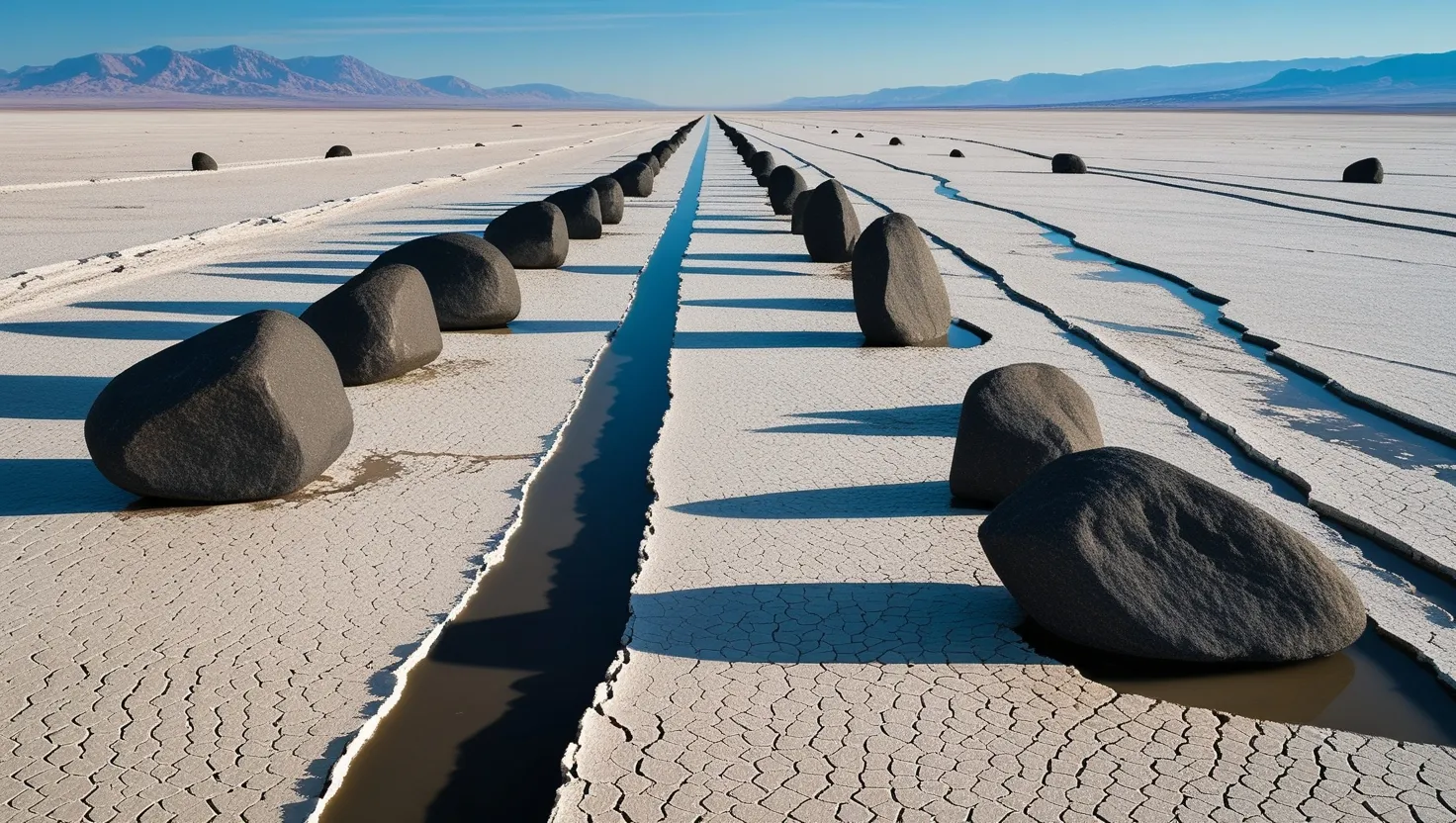If you wander out to Racetrack Playa in Death Valley, the stillness is broken only by your footsteps—and perhaps the lingering question echoing in your mind: Why do these stones move? Imagine staring at rocks, some heavier than a person, with long, crisp trails stretching behind them in the dried mud. The air is dry. The horizon is endless. There’s no trickling sound of water, no footprints, nothing obvious to explain this curious motion. And yet, clear evidence remains: these stones slid, turned, and sometimes even danced across the flat, sunbaked earth.
“Science is a way of thinking much more than it is a body of knowledge.” —Carl Sagan
When I first learned about these “sliding stones” or “sailing stones,” I pictured a prankster or perhaps a hidden magnetic field. Early researchers felt the same. If rocks can move on their own, with nobody to push, why not suspect supernatural happenings or electromagnetic quirks? Some theories stretched into the strange—was it all a well-kept secret by the indigenous people, or was there something fundamental about physics we were missing?
A little history deepens the intrigue. Long before GPS or time-lapse cameras, these trails were described in Native stories, passing through oral traditions as a symbol of the land’s magic. Ranchers and gold-seekers in the 19th century scribbled notes in journals about the odd tracks in the playa. Decades later, scientists with more sophisticated tools would return again and again, trying to catch the stones in the act.
The problem: these rocks move rarely. Sometimes years pass with nothing happening. At other times, whole clusters shift in a single night. If randomness had a stage show, this would be it. I’m drawn by the inconsistency—the way some stones remain frozen while nearby neighbors zigzag ahead, their trails crisscrossing. What flips the switch? Why is such a heavy thing suddenly weightless enough to slide, and why don’t they all slide together?
Let’s ask a simple question: what does it really take to move a boulder? In my own backyard, dragging a ten-pound stone across the dirt leaves grooves and clumps. Multiply that several times—yet here, 700-pound rocks cruise slowly, leaving only a shallow, unbroken line behind.
Here’s a fascinating twist. Early expedition teams tried all sorts of tricks: staking out stones, raking the playa to monitor footprints, and even painting symbols to catch if rocks were secretly being rotated or swapped. In nearly all those tests, movement never happened under direct observation. It was as if the stones shunned an audience.
As decades ticked by, researchers noticed a pattern. Most movements happened in winter, after rare rainfalls. Some experiments found that if the playa was just wet enough, a slick surface built up—mud so fine and level it created a near frictionless surface only in those brief moments after a rainfall. There was plenty left unexplained, though. Could mere wetness move massive rocks?
Then came the ice theory. Not thick polar ice, but thin, almost invisible sheets that glistened under the winter sun. One winter, a team of scientists finally caught the stones’ motion via time-lapse: ultra-thin ice pancakes floated on a shallow meltwater pond, nudged by gentlest winds. These fragments would build up against a stone, and—almost lazily—start pushing it forward. To their delight, cameras captured pebbles and then heavier stones easing ahead, leaving behind fresh trails like a snail’s signature across the mud.
“The most beautiful thing we can experience is the mysterious. It is the source of all true art and all science.” —Albert Einstein
But before you pack your bags and declare the mystery solved, let’s poke a little further. If ice panels are central to the story, why don’t all stones move when the conditions are right? Why do some streak off at sharp angles, while their neighbors stand still? Why do many trails display curves, sudden zigzags, even changes in direction that seem to toy with the idea of steady wind or uniform ice pushes?
This selectivity challenges expectations. A shallow, floating sheet of ice should, in theory, bump every stone in its path, but observation keeps catching exceptions. Sometimes the “passenger” stone skips along, while companions remain rooted. At other times, a stone turns mid-trail for no apparent reason, or a single boulder glides forward while the smallest pebbles in its wake stand fast. If nature is following physics, it’s following it in a delightfully elusive way.
I find the absence of scraping a further puzzle. If mud is just soft enough, and the ice pushes with force, I’d expect scraped edges or plowed clay flanking each line. Yet most trails are clean, sometimes too precise. There’s a suggestion they’re gliding—a motion that hints at low friction, but not necessarily one that matches what we see with normal ice-pushed debris. Sometimes trails begin and end abruptly, as if the stone suddenly decided to drop anchor.
Should we blame wind next? There have been hurricanes in Death Valley, with gusts that could knock over a desert tent. Could concentrated wind on a wet, glassy playa send rocks sliding at jogging speeds? Some mathematical models say yes, but this too fails to explain all movement patterns, especially the rare solo stones scooting ahead while the rest stay put.
Ask yourself: What other system on Earth behaves this way? The combination of rock, wind, water, and ultra-light ice is unique enough, but nothing else seems so picky about techniques for moving. Nature is, it turns out, sometimes a patient and selective experimenter.
Let’s zoom out a bit. What does this teach us about physics? At a glance, it might seem a quirk or a desert trick. Yet, the “sliding stones” touch on broader questions: how do large objects behave at the threshold between solid and fluid motion? What hidden partnerships exist between environmental variables—temperature, moisture, surface texture, wind speed—that, when working in perfect concert, break familiar physical rules? Even small changes can alter the outcome. Mud density, for instance, acts as a gatekeeper; just a sliver too wet or too dry, and nothing happens. The ephemeral “just right” moment can last only hours some years, and not at all in others.
“Somewhere, something incredible is waiting to be known.” —Carl Sagan
This playground for stone, wind, and ice has also caught the attention of engineers and planetary scientists. If the laws here aren’t fully grasped, how can we expect to model similar interactions on other planets? Mars, for example, has vast frozen plains and frequent dust devils. Can small differences in air pressure, surface composition, or seasonal cycles produce surprisingly large movements elsewhere in the solar system? The sliding stones hint at larger patterns—the way simple ingredients can produce unexpected results when conditions are just so.
Speculation continues. Some suggest tiny vibrations from earthquakes might help “unstick” certain rocks but not all. Others wonder about sub-surface pressure—does moisture trapped beneath the playa layer briefly act like a hydroplaning effect? Could there be subtle gradients in the playa’s composition that direct some movements with invisible hands?
And so here we stand, in the 21st century, equipped with satellites, sensors, and high-speed cameras, still chasing a mystery that reveals itself in slow motion. Maybe that’s the most beautiful part. Racetrack Playa is a reminder that even with all our knowledge, the natural world keeps spaces for surprise. These stubborn stones, moving under rare and precise conditions, are teaching us patience—the value of observing, asking, doubting, and accepting that not all puzzles yield on the first explanation.
If you go to Racetrack Playa, stand quietly next to a stone and imagine it tipping into motion—a process both mundane and profound. Think about the years passing in silence between each glide and pause. Ask yourself: What else in nature is happening on a timeline so indifferent to human schedules?
The mystery of the sliding stones isn’t just about physics. It’s about perspective and humility. It’s about realizing that sometimes, questions are more powerful than immediate answers. If history is any guide, the next nudge could come not from the wind, but from simply paying closer attention. The stones are patient. Are we?






